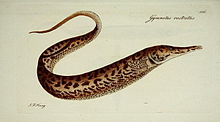
The Gymnotiformes are an order of teleost bony fishes commonly known as Neotropical knifefish or South American knifefish. They have long bodies and swim using undulations of their elongated anal fin. Found almost exclusively in fresh water, these mostly nocturnal fish are capable of producing electric fields to detect prey, for navigation, communication, and, in the case of the electric eel, attack and defense. A few species are familiar to the aquarium trade, such as the black ghost knifefish, the glass knifefish, and the banded knifefish.

The naked-back knifefishes are a family (Gymnotidae) of knifefishes found only in fresh waters of Central America and South America. All have organs adapted to electroreception. The family has about 43 valid species in two genera. These fish are nocturnal and mostly occur in quiet waters from deep rivers to swamps. In strongly flowing waters, they may bury themselves.

The ghost knifefishes are a family, Apteronotidae, of ray-finned fishes in the order Gymnotiformes. These fish are native to Panama and South America. They inhabit a wide range of freshwater habitats, but more than half the species in the family are found deep in rivers where there is little or no light.
Gymnotus is a genus of Neotropical freshwater fish in the family Gymnotidae found widely in South America, Central America and southern Mexico. The greatest species richness is found in the Amazon basin. They are sometimes referred to by the English name banded knifefish, although this typically is reserved for the most widespread species, G. carapo. Overall Gymnotus is the most widespread genus in the order Gymnotiformes.

Sand knifefish are freshwater electric fish of the family Rhamphichthyidae, from freshwater habitats in South America.
Knifefish may refer to several knife-shaped fishes:

Glass knifefishes are fishes in the family Sternopygidae in the order Gymnotiformes. Species are also known as rattail knifefishes.
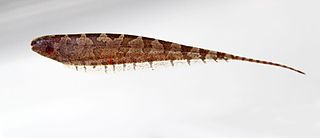
The Hypopomidae are a family of fishes in the order Gymnotiformes known as the bluntnose knifefish. They may also be called grass or leaf knifefishes. These electric fish are not often eaten, of little commercial importance, rarely kept as aquarium fish, and poorly studied; however, species in this family may constitute a significant fraction of the biomass in the areas they inhabit.

The banded knifefish is a species of gymniform knifefish native to a wide range of freshwater habitats in South America. It is the most widespread species of Gymnotus, but it has frequently been confused with several relatives, including some found outside its range like the Central America G. maculosus. The English name "banded knifefish" is sometimes used for the entire genus Gymnotus instead of only the species G. carapo.

Magosternarchus is a genus of weakly electric knifefish in the family Apteronotidae, containing two species. They are endemic to Brazil, occurring in large river channels in the Amazon River basin. Both species are unusual benthic predators that specialize in biting off the tails of other knifefishes, and are characterized by their greatly enlarged jaws and teeth. Recent systematic studies indicate that both species should be included in Sternarchella instead of being placed in their own genus.
Sternarchogiton nattereri is a species of weakly electric knifefish in the family Apteronotidae. It is native to the Amazon River system and feeds on sponges. Unlike other members of the genus Sternarchogiton, there is pronounced sexual dimorphism in S. nattereri, with reproductively mature males developing strong external teeth on tips of their jaws. These males are so different from the females and juveniles that they were thought to be a different genus and species, the "tooth-lip knifefish" Oedemognathus exodon, for over 40 years.
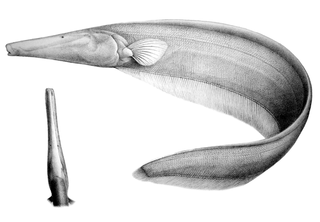
Orthosternarchus tamandua, the tamandua knifefish, is a species of weakly electric knifefish in the family Apteronotidae, native to the deep river channels of the Amazon basin. This species is characterized by its whitish-pink color, long tubular snout, long dorsal appendage, and tiny, bilaterally asymmetrical eyes.
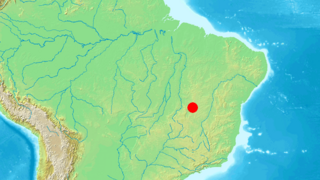
Eigenmannia vicentespelaea is a species of weakly electric knifefish in the family Sternopygidae. Native to the São Domingos karst area in central Brazil, it is the only known knifefish to exclusively inhabit caves. Measuring up to 21 cm (8.3 in) long, E. vicentespelaea can be distinguished from its relatives by its translucent body and reduced or absent eyes. As some individuals retain well-developed eyes, this fish may have colonized caves only recently in evolutionary time.

Tembeassu marauna is a species of weakly electric knifefish in the family Apteronotidae and the only member of its genus, known only from three specimens collected from the upper Paraná River, Brazil, in 1965. This fish can be identified by fleshy extensions at the tips of its upper and lower jaws, with the upper extension bearing a patch of extra teeth. The function of these unique structures is unknown, but may relate to feeding. Apparently a specialized inhabitant of deep riverine environments, T. marauna may be endangered by extensive dam construction in the upper Paraná region, if not already extinct.

Apteronotus is a genus of weakly electric knifefish in the family Apteronotidae, distinguished by the presence of a tiny tail fin. This genus is restricted to tropical and subtropical South America and Panama where found in a wide range of freshwater habitats. They feed on small animals.
Porotergus is a genus of ghost knifefishes found in the Amazon and Essequibo basins in tropical South America. They are found over sandy bottoms in shallow or deep rivers. They feed on small aquatic insect larvae. They have a stubby snout and are fairly small knifefish, with the largest species reaching up to 27 cm (11 in) in total length.
Hypopygus is a genus of South American gymnotiform knifefishes native to the Amazon, Orinoco and upper Paraguay basins, as well as rivers in the Guianas. They are often common, and found near submerged roots, aquatic vegetation and leaf-litter in streams, edges of rivers and floodplains. They are regularly found among vegetation in floating meadows, a habitat that often contains little oxygen, but they are well-adapted to this.
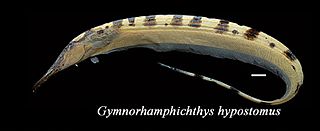
Gymnorhamphichthys is a genus of South American sand knifefishes found in the Amazon, Araguaia, Orinoco and Río de la Plata basins, as well as rivers in the Guianas. They inhabit both small streams and large rivers, but usually over a sandy bottom. During the night they swim head-down over the sandy bottom to locate small invertebrate prey like insect larvae and during the day they rest buried under the sand.

The electric eels are a genus, Electrophorus, of neotropical freshwater fish from South America in the family Gymnotidae. They are known for their ability to stun their prey by generating electricity, delivering shocks at up to 860 volts. Their electrical capabilities were first studied in 1775, contributing to the invention in 1800 of the electric battery.
Apteronotus rostratus is a species of apteronotid electric fish. These fish typically exhibit a wide diversity of skull shapes, ranging from highly elongate skulls to highly foreshortened ones, with both types evolving independently multiple times. In Apteronotus rostratus and some others, such as Compsaraia samueli, mature males grow extremely elongated snouts and oral jaws which are used in agonistic interactions with other males. This is an example of sexual weaponry. A study comparing skull shape and jaw-closing performance in males and females of Apteronotus rostratus suggested that males with elongated faces for use in fights did not have lower mechanical advantages, in contrast to the similar species Compsaraia samueli in which males exhibit a trade-off between sexual weaponry and jaw leverage.

